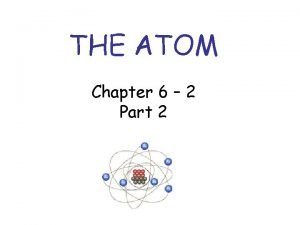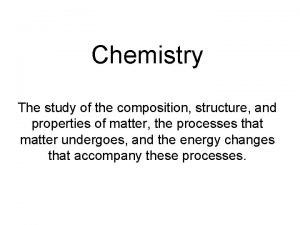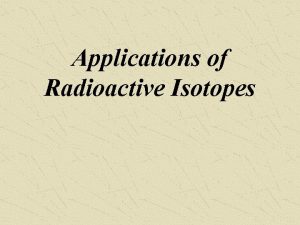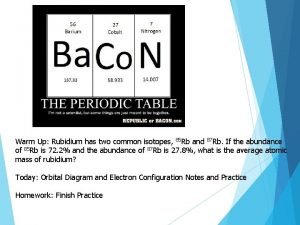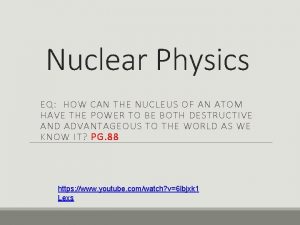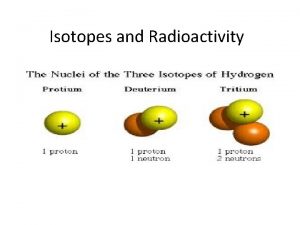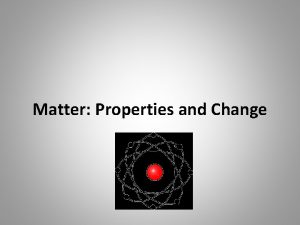Structure and Properties of Matter Isotopes Unit 1















- Slides: 15

Structure and Properties of Matter Isotopes Unit 1 - Lesson 5

Isotopes Learning Objectives • Describe what isotopes are and how they form. • Outline the uses of isotopes. Core Vocabulary: Isotope, protium, deuterium, tritium, stable isotope, radioisotope, parent isotope, daughter isotope, medical isotope

Isotopes Definition: • Isotopes are different forms of the same element which have the same number of protons but differ in their number of neutrons. • A variation in the number of neutrons in the nucleus causes the atom’s mass to change. Many elements on the periodic table have naturally occurring isotopes.

Isotopes Chemical Properties: • With the exception of hydrogen, the chemical properties of isotopes are very similar, if not identical to one another. • This is due to the number of electrons in each isotope of an atom remaining the same. Electrons determine the way an element behaves.

Isotopes Physical Properties of Isotopes: • The physical properties of isotopes vary to each other since these properties often depend on mass. • This difference may be used to separate isotopes of an element from each other by using fractional distillation and diffusion.

Isotopes Isotope Notation: There are two ways to write isotopes: • Element Name - Mass Number. For example, carbon has an isotope with 6 protons and 6 neutrons called carbon-12 or C-12. The isotope of carbon with 6 protons and 7 neutrons is carbon-13 or C-13. • The mass number (A) is written in superscript in the upper left corner of an element symbol, while the atomic number (Z) is placed below it. For example, the isotopes of hydrogen are written:

Isotopes Isotope Names: • In most cases, the isotopes of an element have the same name and are recognized with a different mass number on the suffix. For example, oxygen has three isotopes – oxygen-16, oxygen 17 and oxygen-18.

Isotopes Isotope Names: • One exception to this is hydrogen, which has distinct names for each of its three isotopes: Attribution: Bruce. Blaus [CC BY 3. 0 (https: //creativecommons. org/licenses/by/3. 0)], from Wikimedia

Isotopes Stable Isotopes: • The ratio of protons to neutrons in the nucleus of an atom determines its stability. Isotopes which are unstable are radioactive. There are 275 isotopes of the 81 stable elements in the periodic table. • In a few cases, stable isotopes are able to undergo radioactive decay; however, this occurs at a very, very slow rate. For example, Bismuth-209 is known to be a stable radioactive isotope. It undergoes alpha-decay but has an extremely long half-life of 1. 9 x 1019 years (more than a billion times longer than the estimated age of the universe).

Isotopes Radioactive Isotopes: • Radioisotopes undergo radioactive decay by emitting, or kicking out, subatomic particles to reach a more stable, lowerenergy, configuration. This may lead to a change in the number of protons in the nucleus which then causes the identity of the atom to change (for example, carbon-14 decays to nitrogen-14).

Isotopes Radioactive Isotopes: • The initial isotope is termed the parent isotope and the resulting isotope is called the daughter isotope. For example, when Uranium-238 decays into Thorium-234, the uranium atom is the parent isotope, while thorium atom is the daughter isotope. In some instances, more than one type of daughter isotope can occur depending on the type of radioactive decay that occurs.

Isotopes Where do isotopes come from? • Other than via radioactive decay, it has been hypothesized that lighter isotopes came together sometime soon after the Big Bang, while heavier ones were made in the cores of stars. • The interaction between cosmic rays and energetic nuclei in the upper-most atmospheric layers can also sometimes lead to the formation of isotopes.

Isotopes Uses of isotopes • Isotopes are often used for dating objects e. g. carbon dating. This is possible since unstable isotopes are able to decay into stable ones at a predictable rate (this is known as their half-life). For example, the half-life of Carbon-14 (C-14) is 5, 730 years. C 14 is originally formed in the atmosphere and is then ingested by living organisms in the form of plant tissue through photosynthesis. An animal ingests about one C-14 atom for every trillion stable C-12 isotopes through the food it eats. While the organism is alive the ratio of C-12 to C-14 remains stable, however once it dies, it stops ingesting C-14. Scientists can use mass spectroscopy to look at how many C-14 atoms a sample has and can, therefore, calculate how far through C-14’s half-life it is, which then allows them to calculate an organism’s age.

Isotopes Uses of Isotopes • PET (Positron-emission tomography) scans use the decay of ‘medical isotopes’ contained in special dyes to look inside the human body. • The scan is able to identify differences in tissues at the molecular level and can assist doctors in diagnosing diseases as well as monitor body functions such as blood flow, oxygen usage and the uptake https: //commons. wikimedia. org/wiki/File: PET_ scan-normal_brainof glucose (sugar) molecules. alzheimers_disease_brain. PNG

Isotopes Uses of Isotopes: • Creating ‘enriched’ materials, such as enriched Uranium, for use in nuclear reactors. • This process involves separating naturally-occurring uranium atoms from heavier, more unstable and thus more radioactive isotopes. The metal which has been sifted through for heavier isotopes is called ‘depleted uranium’.
 What is isotope
What is isotope Isotopes properties
Isotopes properties Study of the composition structure and properties
Study of the composition structure and properties What is
What is Isotopes pogil
Isotopes pogil What is white matter made of
What is white matter made of Optic tract
Optic tract Gray matter and white matter
Gray matter and white matter Gray matter vs white matter
Gray matter vs white matter Fertile isotopes
Fertile isotopes Isotope abundance formula
Isotope abundance formula Atomic weight of oxygen
Atomic weight of oxygen Atomic isotopes
Atomic isotopes Applications of radioisotopes
Applications of radioisotopes Rubidium orbital diagram
Rubidium orbital diagram Four fundamental forces of nature
Four fundamental forces of nature
